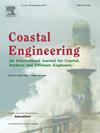理想化浮动海藻养殖场引起的波浪阻尼物理模型研究
IF 4.2
2区 工程技术
Q1 ENGINEERING, CIVIL
引用次数: 0
摘要
为研究理想化浮动海藻养殖场所产生的随机波浪阻尼,进行了一项物理建模研究。实验条件跨越了中间水深以及线性和非线性水波。与以往研究植被对波浪的阻尼作用不同的是,浮动海藻养殖场靠近水面,植被高度与水深之比接近 0.25。浮动海藻养殖场引起的波浪传播系数介于 0.56 和 0.96 之间。浮动海藻养殖场越长,该系数越小,它是海藻养殖场长度与入射波长之比以及相对波深的函数。频谱分析表明,在波峰频率附近,波浪阻尼与频率无关。约有 100 条养殖线、延伸长度约为 200 米的浮动海藻养殖场的波浪传播系数与相对波峰自由板小于-0.4 的水下分离式防波堤的波浪传播系数相似。此外,近水面理想化浮动海藻养殖场的体积阻力系数可模拟为 Keulegan-Carpenter 数的函数。这项研究强调了浮动海藻养殖场等基于自然的海岸保护解决方案的潜在可行性。本文章由计算机程序翻译,如有差异,请以英文原文为准。
Physical modelling study on wave damping induced by an idealized floating kelp farm
A physical modelling study was carried out to investigate random wave damping promoted by an idealized floating kelp farm. The experimental conditions spanned intermediate water depths and both linear and nonlinear water waves. Unlike previous studies of wave damping promoted by vegetation, the floating kelp farm was placed close to the water surface with a ratio between vegetation height and water depth close to 0.25. The wave transmission coefficient induced by the floating kelp farm ranged between 0.56 and 0.96. This coefficient decreased for longer floating kelp farms and it was a function of the ratio between kelp farm length and incident wavelength and of the relative wave depth. Spectral analysis showed that wave damping was not frequency-dependent for wave frequencies close to the peak frequency. The wave transmission coefficients of a floating kelp farm with about 100 culture lines and with an extension of approximately 200 m were similar to those of submerged detached breakwaters with a relative crest freeboard smaller than −0.4. Furthermore, the bulk drag coefficient of near-surface idealized floating kelp farms can be modelled as a function of the Keulegan-Carpenter number. This study highlights the potential viability of nature-based solutions such as floating kelp farms for coastal protection.
求助全文
通过发布文献求助,成功后即可免费获取论文全文。
去求助
来源期刊

Coastal Engineering
工程技术-工程:大洋
CiteScore
9.20
自引率
13.60%
发文量
0
审稿时长
3.5 months
期刊介绍:
Coastal Engineering is an international medium for coastal engineers and scientists. Combining practical applications with modern technological and scientific approaches, such as mathematical and numerical modelling, laboratory and field observations and experiments, it publishes fundamental studies as well as case studies on the following aspects of coastal, harbour and offshore engineering: waves, currents and sediment transport; coastal, estuarine and offshore morphology; technical and functional design of coastal and harbour structures; morphological and environmental impact of coastal, harbour and offshore structures.
 求助内容:
求助内容: 应助结果提醒方式:
应助结果提醒方式:


